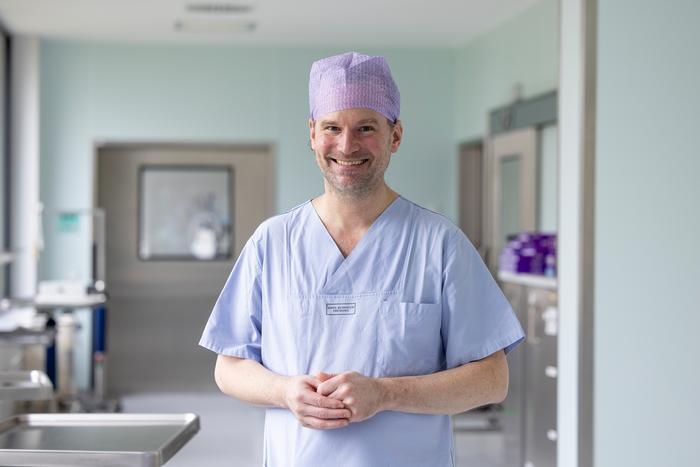Heart, lungs, brain, aorta: elevated to the highest league as an organ

Credit: Medical Center – University of Freiburg / Britt Schilling
Heart, lungs, brain, aorta: elevated to the highest league as an organ
“Recognising the aorta as an organ puts it on a par with the heart, lungs or brain. This is a big step,” says Czerny, Medical Director of the Department of Cardiovascular Surgery at the University Heart Centre of the Medical Center – University of Freiburg. Until now, aortic diseases have usually been treated either in cardiac surgery or in vascular surgery, depending on their type and location. “The new guidelines clearly recommend bundling the treatment of the aorta in a separate speciality, naturally in close coordination with other specialities. We have been practising this integrative approach at the Medical Center – University of Freiburg for a long time and I am delighted that our work is now also being recognised internationally,” says Czerny. “I am certain that this will improve the treatment of patients with aortic rupture and other serious diseases.” The guidelines could also have an influence on the content of medical studies and specialist training.
Czerny has been one of the world’s most cited scientists in the field of cardiovascular surgery for many years. Other doctors from the Department of Cardiovascular Surgery, the Department of Diagnostic and Interventional Radiology at the Medical Center – University of Freiburg and numerous international doctors were involved in the commission to develop the new guidelines under Czerny’s co-leadership.
“The high level of expertise at the Medical Center – University of Freiburg in the field of cardiovascular medicine is a core pillar of our quality-centred, cutting-edge university medicine,” says Prof. Dr. Frederik Wenz, CEO of the Medical Center – University of Freiburg. “Prof. Czerny and his team once again confirm the outstanding position of our University Heart Centre Freiburg – Bad Krozingen throughout Germany,” says Wenz.
The aorta has complex tasks and functions
The aorta is responsible for transporting oxygen-rich blood from the heart to the rest of the body. In recent years, it has become increasingly clear that it also plays an important role in regulating blood pressure and blood flow velocity. In addition, it is involved in the production of certain hormones and has its own layer of smooth muscle cells that help to maintain its structure and function.
The new guidelines describe the procedure for diagnosing and treating diseases of the aorta such as aortic aneurysm. An aneurysm is an abnormal bulge in the aortic wall that harbours a high risk of an acutely life-threatening rupture. If the aorta ruptures, emergency surgery is required. “These diseases require complex surgical interventions, which we can better understand, research and perform thanks to the holistic view of the aorta,” says Czerny. “Very good follow-up care is also very important, as those affected often show dangerous changes in the aorta again later in life,” says Czerny.
Guidelines support diagnosis and treatment
Clinical practice guidelines summarise and evaluate all relevant findings on a specific topic at the time they are drawn up. These guidelines take into account the risk-benefit ratio of various diagnostic or therapeutic methods. As an important tool, they support doctors in making decisions in their daily practice.
Treatment example:
Helga A. (59) was on her way home from a strenuous midwifery shift in 2020.”It came out of the blue. I felt an incredible pressure in the left side of my neck, radiating down to my legs, and nausea,” says A, who was sitting in the car at the time and suddenly couldn’t move her legs.”I was aware that it was something threatening,” says A. looking back.”I was in a lot of pain, but fortunately I was still able to express my wish to be taken to the Freiburg – Bad Krozingen Heart Centre.” The computerised tomography scan actually revealed a tear in the aorta very close to the heart, which was acutely life-threatening.The operation was successful.”I learnt that not all people with a rupture of the aorta very close to the heart are as lucky as I was,” says A. In fact, half of those affected die within 24 hours if left untreated.” After I had survived everything, I felt like I had a second birthday,” says A., who has experienced many birthdays herself as a midwife.
As with many patients with aortic aneurysms, A. experienced problems again. She needed a second operation in 2023, this time on the part of the aorta in the abdomen. The pathological changes were discovered during a follow-up examination, which A. regularly attends at the Aortic Centre of the University Heart Centre. “That also went well and I’m looking forward to the future,” says the patient.
Journal
European Journal of Cardio-Thoracic Surgery
DOI
10.1093/ejcts/ezad426
Method of Research
Systematic review
Subject of Research
People
Article Title
EACTS/STS Guidelines for diagnosing and treating acute and chronic syndromes of the aortic organ
Article Publication Date
26-Feb-2024




